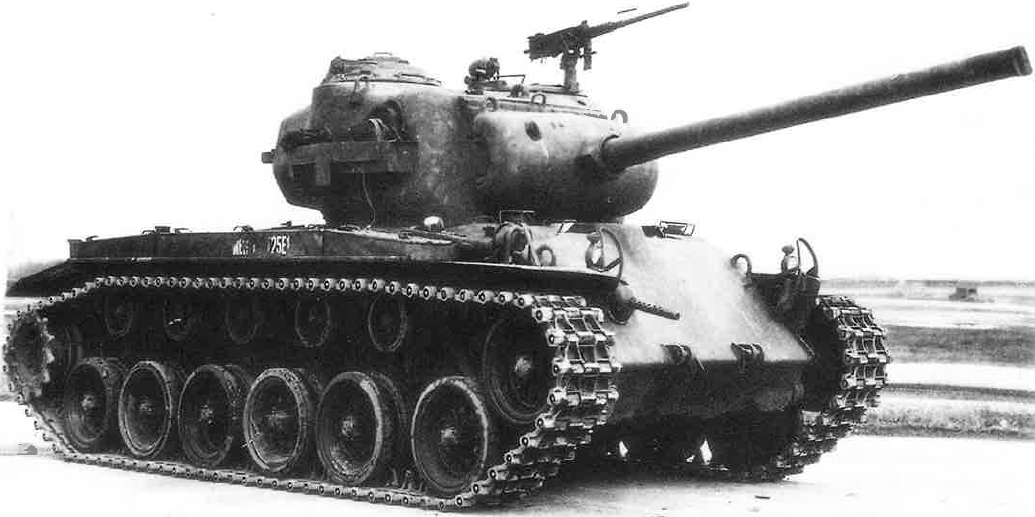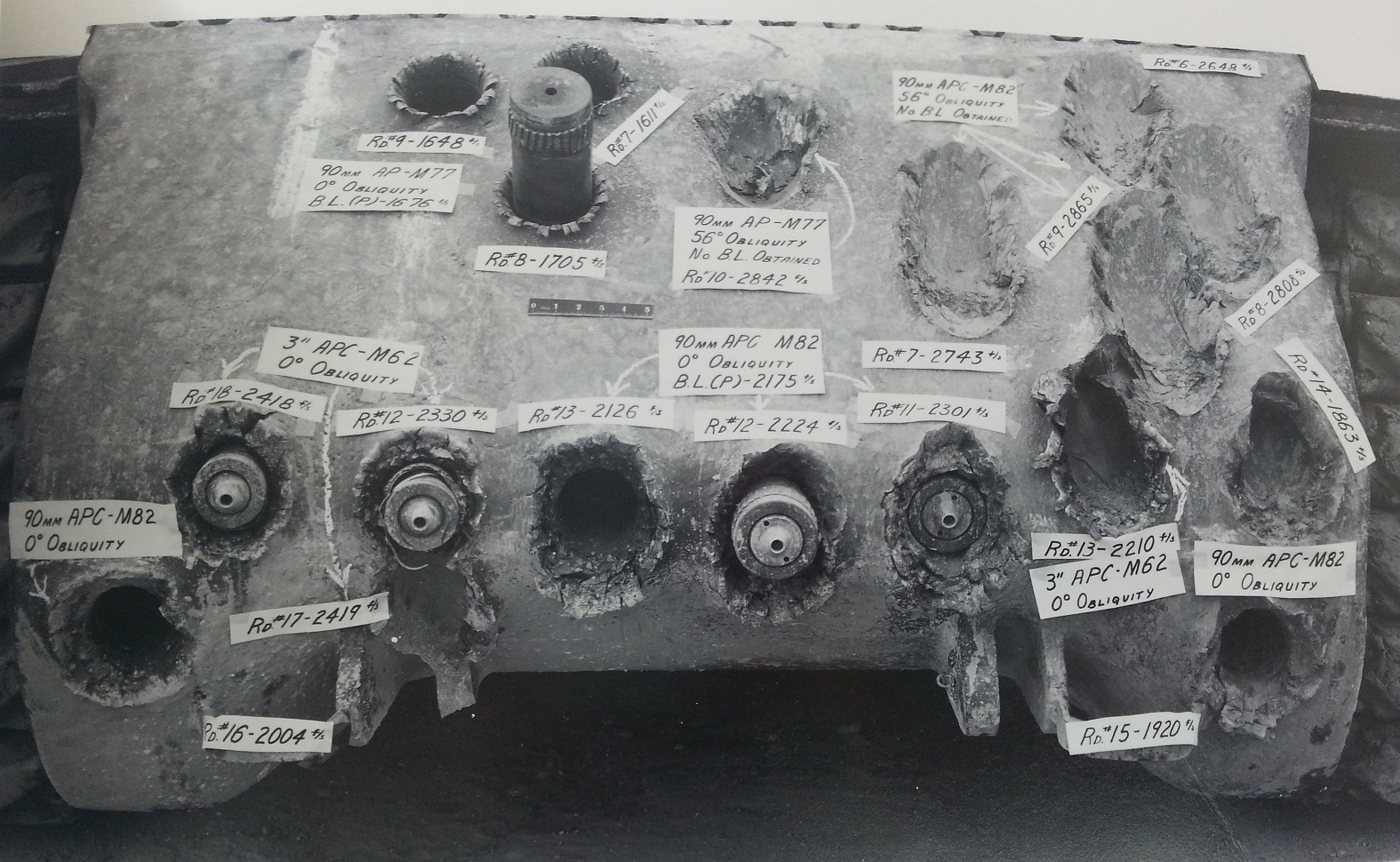
First up, Merry Boxing Day, happy food coma, and whatever else is going on in your lives.
I move now to part 3 of Army Ground Force’s activities with respect to tank procurement. Last time around we covered the period of about a year from autumn 1942, we move now to 1943. Part 1, a more general overview of how AGF did business, is here. I return us now to the AGF historian.
____________________________________________
Determining Production Policy: Fall of 1943
For the time being, emphasis was now placed on the modified T25 and T26 series of tanks, pilot models of which were nearing completion in the fall of 1943. The T23 had not passed from the picture, however, as later developments will indicate.
In November of 1943, ETO (European Theater of Operations) requested the highest priority be given development of the T26E1 tank, mounting a 90mm gun. General Devers, then Commanding General of ETO, requested production of 250 of these tanks on the basis of providing one for each five M4s. Ordnance Technical Division concurred in this recommendation, but also recommended production of at least 1,000 of the T23 tanks. The War Department submitted these proposals to Army Ground Forces for comment. Both the Ground Requirements and Ground Engineer Section urged General McNair not to concur in the proposed T26E1 production. They believed that service tests of this tank sould be made, and also that the tank should not be used until suitable tactical bridging was available – which would not be at an early date. General McNair repeated his earlier position that we should defeat Germany by use of the M4 series of tanks and that a suitable tank destroyer was the logical answer to the heavier German tanks.
The Army Ground Forces’ reply to the War Department was contained in two papers. Both of these emphasized the suitability of the M4 series, particularly when improved by new center-guide tracks. The Army Ground Forces again rejected the T23 tank and electric drive until that drive had proved itself at least equal to other power trains. It was recommended that the T26E1 be continued as a development type only, since in the opinion of General McNair, battle experience had demonstrated that the anti-tank gun in suitable numbers and disposed properly were master of the tank.
General Devers’ position on the T26E1 was not shared by General Eisenhower, then Commanding General of NATO (North African Theater of Operations), who did not want it because of its “excessive weight” and did not believe that the increased armor was justified in view of this increased weight and lack of maneuverability. Army Service Forces [Chieftain’s note: The guys who develop and buy the equipment] asked that the War Department reconcile these divergent opinions. When General Devers repeated his request for production of the T26E1, the War Department issued a directive to Army Service Forces to produce the tanks to fill this operational requirement. It was recommended to General McNair by the Requirements Section that Army Ground Forces’ objections be repeated and brought to the attention of the War Department. General W.F. Dean pointed out that no vehicle of the type had ever been found satisfactory in the pilot model, and that in addition torsion bar suspension had never been used on vehicles even half as heavy as the T26 [Chieftain's note: Obviously Panther and Tiger are the lie to that statement, but he probably referred to US knowledge and experience, which was more relevant]. The adequacy of the power plant was questioned since the Germans used greater horsepower on any vehicle over 40 tons. The torquematic transmission proposed for the tank was just then proving satisfactory on vehicles less than half the weight of this tank (76mm M18 Tank Destroyer and T24 Light Tank). General McNair, in a characteristic memorandum, refused to continue the controversy. He believed that Army Ground Forces had stated all these objections before and that higher authority had ruled against them. He was willing to accept the decision of his superiors in the spirit of the soldier. He personally preferred merely to keep production facilities open and would not object to manufacture of a sufficient number to achieve this purpose, but would take no further stand to press his views. Accordingly, a production schedule was estabilised for the completion of the 250 tanks by April 1945. [Chieftain's note: This was done in January 1944. For a review of the Pershing's development timeline, I refer you to Producing T26, Pt 1., and Ordnance's side of the story is found in Producing Pershing Part2.]
The Ordnance Department followed this authorization by recommending that five of the production models of the T25E1 and one T26E1 be sent to NATO for “battle evaluation”, accompanied by introductory teams of specialists. They also revived the T23 question and asked that five tanks also be sent overseas for battle evaluation. Army Ground Forces would not concur in these proposals. It pointed out that these tanks had not been service tested and that the combat zone was not suitable for such testing. The activities of introductory teams, in the opinion of Army Ground Forces, should be limited to demonstration of the tanks and conferences with officers and soldiers who had been in combat. For the time being, this project was set aside.
T25E1 versus T26E1
As between the T25E1 and T26E1 Army Ground Forces preferred the lighter T25E1, believing it would have mobility almost equal to that of the M4 and would provide the necessary fire power (90mm gun). These tanks were similar except in armor (and consequently weight) and suspension. The T25E1 weighed approximately 38 tons and the T26E1 approximately 43 tons; both employed a 90mm gun and torsion bar suspension; the latter, however, had 24-inch tracks compared with 19-inch tracks on the T25E1. Army Ground Forces urged, therefore, on the assumption that T25E1 service tests would prove satisfactory, that plans be drawn for re-equipping half of divisional and separate tank battalions with the T25E1 and that M4 production be terminated. Two major changes were proposed. At the insistence of General McNair, the 90mm gun was to be replaced with a 76mm gun and the wider suspension system of the T26E1 was to be incorporated. These changes would further decrease the unit ground pressure of the T25E1, and the lighter 76mm ammunition would facilitate firing and permit greater ammunition stowage. The War Department returned this recommendation for further study and at the same time increased the T26E1 production by 2,000, 1,800 of which were to be armed with the 90mm gun, and 200 with the 105mm howitzer.

T25E1
General McNair reconsidered his proposal and now modified his policy regarding the T25E1 tank. He was persuaded to accept the views of the European Theater that tanks would unavoidably meet tanks and that our armor and fire power must be sufficient to fight tank duels with German armor. He agreed, therefore, to concur in production of the T26E1 in place of the T25E1 in the 1945 tank program, which had now been increased to almost 6,000 of these tanks, although they were still in the process of service test. Army Ground Forces did, however, ask for development of both the T25E1 and the T26E1 with a 75mm and a 76mm gun and with the provision of stowage for at least 100 rounds of ammunition. Ordnance wanted to place this development on very low priority, but Army Ground Forces asked that it be carried forward as soon as the design of T26E1 with the 105mm howitzer was completed. [Chieftain’s Note: This vehicle would, of course, be developed as the M45. See M45 article]
Again, in August 1944, Ordnance moved to obtain combat tests of the 90mm T25E1 and T26E1 tanks, and the War Department directed formation of a tank platoon in NATO for this purpose. This course of action was strenuously objected to by both the Armored Board and Army Ground Forces. The War Department finally approved Army Ground Force’ stand and cancelled the proposed combat tests, as it had that of the T23.
Ordnance then attempted to obtain standardization of the T26E1 before completion of the service tests. Army Ground Forces did not concur in this proposal, pointing out that remedial actions found necessary by the Armored Board had not yet been taken and that standardization at that time would facilitate neither the development nor the production of the tank. Army Ground Forces would not move toward standardization until the modified model had been service tested and found battleworthy. They knew that modification of a standard item in production was more difficult to achieve than of one still classified only as a development type. There the matter rested until the end of the year.
Assault Tank M4A3E2 – 1944
As early as February 1944, the Developments Division, Army Ground Forces, was convinced that more heavily armored tanks were going to be needed in the coming assault on Fortress Europe, and that they would be needed before either the T25E1 or the T26E1 would become available. Colonel Dean, Chief of the Armored Branch, believed that an expedient could be provided by providing additional armor to the M4 series of tanks, using extended end connectors to offset somewhat the additional weight. To achieve the same result, Ordnance favored modernizing the turret of the M6 heavy tank and instituted an Ordnance Committee action to that end. Army Ground Forces opposed this idea and pointed out in its non-concurrence that there were many other deficiencies in the M6 tank. To make the vehicle battleworthy would require complete modernization. Army Ground Forces had urged modernization in 1943 when tests of the M6 showed its inferiority. Nothing had been done and Army Ground Forces was unwilling to subscribe to any development of the tank unless it included a complete redesign.
A conference of War Department, Army Service Forces, Ordnance, and Army Ground Forces representatives was held, and Army Ground Forces prevailed in obtaining a limited procurement of modified M4 tanks. It was proposed to mount a new final drive casting with 5 ½ inches of armor and to weld an additional 1 ½ inches to the front plates and upper side plates. A new turret with 6 inches of armor would replace the standard turret. This tank would weigh about 42 tons, but was limited to 15 pounds ground pressure. A limited procurement of 250 was established, 200 to be made available by 15 August, and the remainder by the end of August. The Chief of Engineers did not concur in this production because of the lack of tactical bridging, but Army Service Forces was ready to go ahead over the non-concurrence of the Chief of Engineers as soon as War Department G-4 gave its approval. Ordnance emphasized the need for immediate approval, because of the labor situation. A 10-day delay might mean a 20 or 30- day setback in the start of production. War Department G-4 supported Army Ground Forces and issued its directive as requested.

Ordnance Department did a “magnificent job” in producing the M4A3E2 tank. The project was handled by the Ordnance Production and Engineering Divisions and the Technical Division was little concerned. All possible shortcuts were used, and the tanks rolled off as promised. Actually, the last of the limited procurement was delivered only two weeks after the original schedule had been agreed upon, and this delay was due to the time interval necessary to get the production program approved by the War Department.
The tanks proved to be an unqualified success. These vehicles reached France as the US Army came up against the highly fortified German lines, and in the close infantry combat of the fall of 1944 they proved their worth. Some commanders even requested that all medium tank production be in this type, and Army Ground Forces considered re-opening production of this tank in December 1944 [Chieftain’s note: Now I’m reading it, it explains the drawings for a new, improved turret which I found in the National Archives . And yes, the lads in Minsk have it, if they want to use it]. Army Service Forces believed that to make even 500 or 1,000 would require additional facilities which would not be available until late in 1945. Production of all M4A3 tanks was to be completed by April. The Armored Board in February 1945 joined the theaters in asking for further development of this tank, based on an M4 chassis. They recommended using the T26 turret, new horizontal volute suspension, and a 7 to 8 inch armor basis. Army Ground Forces did not favour this in view of the Ordnance information on production possibilities and the fact that the T26 series was now becoming available.
Instead, Army Ground Forces recommended that a similar development be undertaken using the T26E1 chassis and increasing its armor basis to equal that of the M4A3E2 without increasing the ground pressure. Army Service Forces approved this action, but Ordnance pointed out that there would be a 50% loss in tank production for at least 60 days and that six months’ lead time would be needed to produce this heavier armored tank (which in the meantime had been classified as the Heavy Tank T26E5).
The successful development of the M4A3E2 tank indicated more than ever to Army Ground Forces the desireability of getting the M6 out of the picture once and for all. Accordingly, it recommended in July 1944 that it be declared obsolete. This proposal was not brought to the Ordnance Technical Committee, because the Ordnance Department was now attempting to revive the M6 by incorporating a 105mm gun. A wooden mock-up was inspected by representatives of the Armored Board and Army Ground Forces Developments Division. When the formal action was brought before the Technical Committee, Army Ground Forces again assembled all its arguments against the M6 in a strong non-concurrence. It concluded that since the vehicle could not proceed to the point of employment under its own power and could not be transported(because of width and weight), it would be able to reach the scene of an engagement “only through a combination of the most unusual, unexpected, and fortunate events.” The item was withdrawn.

In January of 1945, Ordnance again sought to revive interest in the M6 tank by proposing to offer the available models to the theaters. Army Ground Forces opposed this move (in a statement signed by the Commanding General himself), in spite of the heavy tank losses suffered in the winter campaign of 1944-45. This memorandum was presented by General Waldron at a conference attended by General Somervell and representatives of the War Department General Staff, the Ordnance Department, and Army Ground Forces, held on 5 January 1945. Utilization of this tank and also the equally obsolescent T23 in the theaters was discussed. The M6 was dropped from further consideration but the question of the T23 was left open for the time being.
___________________________________
But wait! There's more!
Actually, it'll take another two parts to complete looking at AGF's side of the tank development and production saga.
In the meantime, Festive Bob has returned, and will take you to the forum thread.

